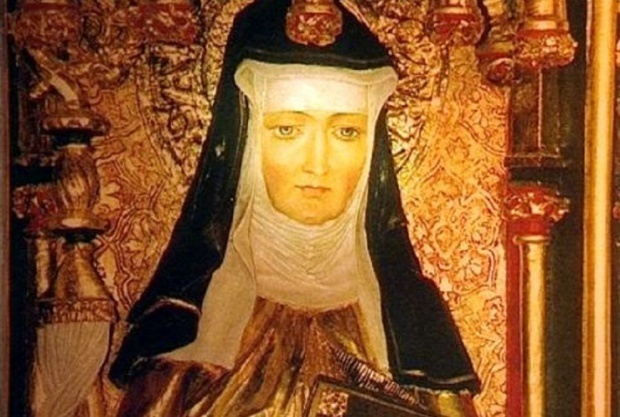Hildegard of Bingen is a saint full of contradictions. Despite being known primarily for her writings, some of which were quite intellectual, Hildegard was all about embodiment in the world of God’s creation. She was not classically trained or educated, and yet we have more writings from her than from almost any other woman of her era. And she repeatedly claimed to be an unlearned woman, unworthy of any claim to biblical exegesis; but yet she used this claim to her advantage, setting the stage for her divine visions and her theological interpretations of them to be accepted as coming straight from God, in a time when they would not have been accepted if they had been perceived as coming from her.
Throughout her 12th century life in what is now known as Germany, she had visions of God and the Divine at work in the world around her, and in her own life. She had visions of God’s creation, expanding upon the narratives in the Bible to create graphic descriptions of the prologue to John’s Gospel, in which God appears in female embodiment as Divine Love or Wisdom. She expanded upon her own visions, writing not just what she saw but also what she knew them to mean. And she accomplished this all at a time when female authority or ability to teach would have been severely curtailed had it not been seen as coming from God.
One of the most touching visions she recounts is one that stayed with her throughout her entire life. Writing at the age of 77, she wrote:
From my early childhood… I have always seen this vision in my soul, even to the present time when I am more than seventy years old. In this vision my soul, as God would have it, rises up high into the vault of heaven and into the changing sky and spreads itself out among different peoples, although they are far away from me in distant lands and places.[1]
She goes on to describe this vision as a “reflection of the living light,” referring to the way visions come to her from God as though they were reflected off a surface such as the light of the sun reflected off water. However, I like to focus on the particularity of the quote above, because, if anything, it speaks to her having some knowledge that her own life would have a significance greater than anyone around her might have let on, especially at such an early age. In short, I see this recounting of her vision as an early example of the “humble brag,” and all the better for her that she was able to get away with it!
Visionaries and mystics are often able to get away with saying things that “normal” people would never be able to say, know, or even think without questioning their state of mind (or orthodoxy). Many of the things they say, however, end up having an amazing kernel of truth to them that only gets recognized much later (like, for example, the more recent resurgence in popularity of Hildegard’s works and writings). That was true in Saint Hildegard’s time, and I am willing to wager that it is true in our time, as well. I only wonder: what things are mystics saying today that we are discounting or not paying any attention, that will be picked up and counted as “before their time” some many years from now? God only knows.
Peter Levenstrong is Associate Rector at St. Gregory of Nyssa Episcopal Church in San Francisco. Having grown up non-religious, he enjoys bringing “a fresh pair of eyes” to examine the tradition of the Episopal Church, and is particularly interested in the intersection of faith and justice. You can find him online on Twitter at @_Rev_Lev.
[1] Newman, Barbara. “Hildegard of Bingen: Visions and Validation.” Church History 54, no. 2 (1985): 163–75.
Image: Ildegarda von Bingen at wikimedia commons

